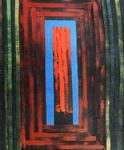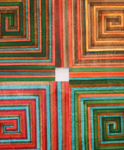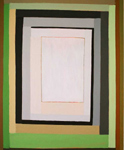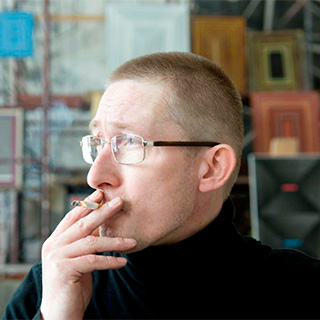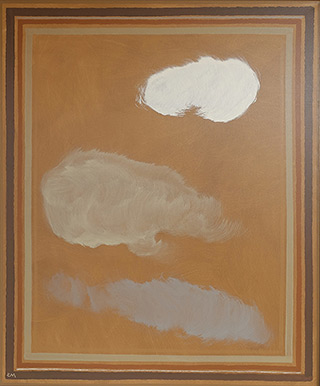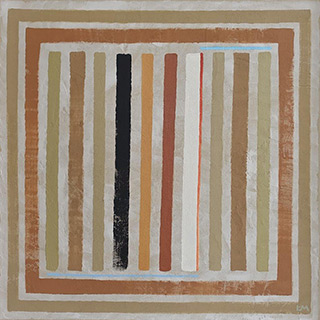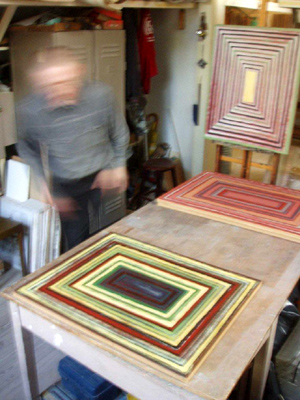A Meander
For Lukasz Majcherowicz there is only one kind of painting – he believes that dividing it into mural and easel painting is ludicrous. He does both; sometimes he carries over a canvas painting onto a wall. They both have only one aim – to introduce the viewer to the world of the painting. It is of course much easier with the murals because a wall painting is a total art – it works with its scale, surrounds us, makes us incautiously enter right into the middle of it. However, Majcherowicz manages to achieve the same effect with small-scale paintings as well.
Are murals the archetypes for you?
Yes, the first signs and paintings were murals – the Prehistoric, and then the Ancient art. It was always very important and very interesting for me. I used to watch my father work – he used to do polychrome restoration. I used to go to his workshop and I got into it. I applied for the Academy of Fine Arts in Poznan, as that was where I wanted to study. Soon it turned out that the mural workshop over there was rather weak and I would not learn anything. So after I year I returned to Warsaw. Just for the murals.
You usually restrict the colour scheme of your paintings, both oil and acrylic, to a dimmed palette characteristic for mural painting.
Sienna, ocher, the colours of earth – this palette is beautiful and more than sufficient for me. All the technological colour improvements of nineteenth and twentieth centuries seem to be redundant. Colour is obviously very important. Even the most important in murals as murals influence viewer’s sensitivity with colours. Everything else is secondary.
All your works are romantic, poetic, contemplation-like, and even mysterious – they interact with senses.
Yes indeed, the painting is purely sensual for me. My mentor, Prof Stefan Gierowski told me once “a painter doesn’t have to know”. Intellectualism, a scientific discourse in art really tires me out. What counts is the unpredictable, the fact that a colour can surprise me. A painting must be unpredictable to an extent, not mathematically calculated. It should bring out feelings – first mine then, hopefully, the viewer’s. To paint I have to focus, calm down and forget the surrounding, reach deep inside me. If I can achieve this state of mind there is a chance the painting will be good, real. That’s why these paintings are so much personal.
Do you always manage to achieve it?
I keep on painting until I do. I have to do it to be satisfied. Of course, it’s much easier to focus and switch off thinking when I paint on canvas. Mural paintings are much more demanding – I have to see to all technical and organizational details: the scaffolding has to be put up; everyone’s work and deadlines have to be coordinated. So there is a lot of rushing and noise… One needs a lot of strong will to get away from all this commotion and still paint in a way that the final effect is satisfying. Painting is to be mainly decorative but still it must be creative.
You are not interested in copying the external world or connotations to everyday life – so called ‘topicality’. Is it easier, for you, to express what’s important through abstract compositions?
Well, it seems this way of depicting is closer to me. And what is the abstract anyway? I even tried to find out once from Henryk Stazewski as I thought that he was bound to know. And he told me that the important thing was to apply one colour next to another in a right way. And I stick to it.
A colour next to a colour, a strand next to a strand – your paintings draw the viewer’s attention with their rhythm.
I believe that painting and music work in a similar way. Rhythm, harmony, and a moment of disharmony, silence – it’s good when a painting can ‘play out’. In glazing techniques, a brush stroke, appliance of the paint, leaving a mark, a strong hand movement – not too slow and not too fast – they are all important to me.
You keep coming back to the motif of a meander. You elevate a purely decorative ornament to a dimension of a symbol.
A meander – leading astray – is a labyrinth, going in circles, seeking. It is endless wandering, pushing ahead. It’s a road to one’s destination. Sometimes, it’s a road without destination. Just like life. Like painting.


